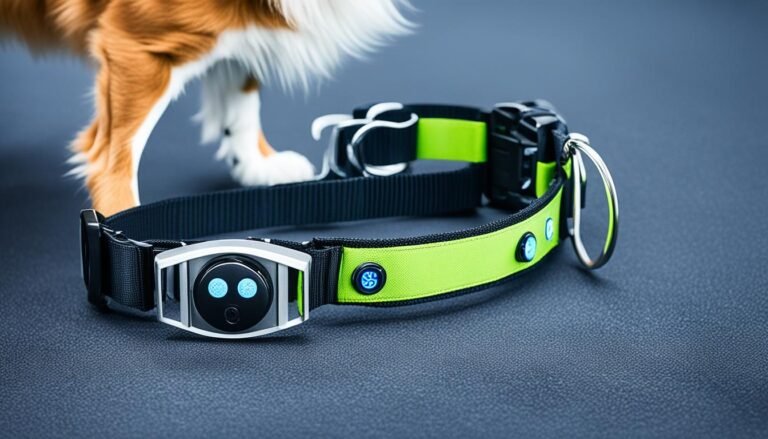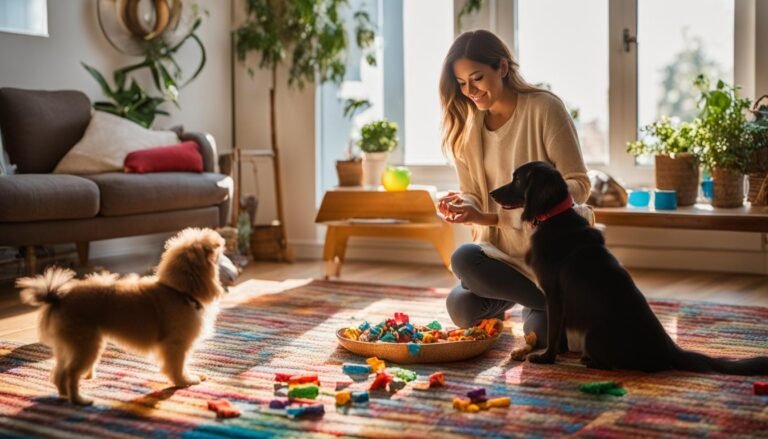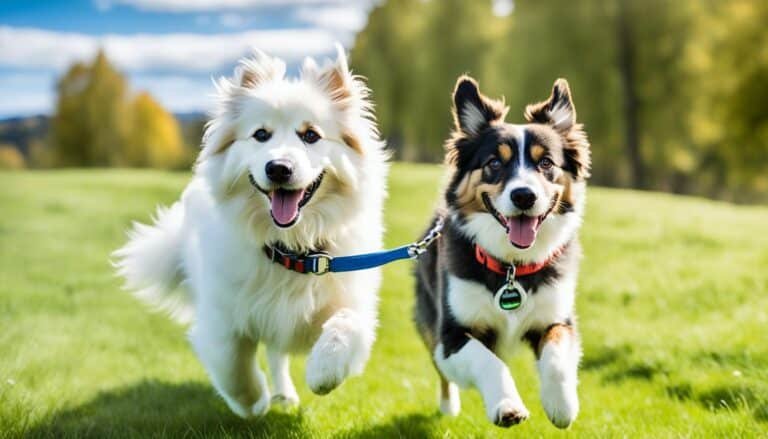How to Train a Hyper Dog
Meet Bailey – a playful and energetic golden retriever who always keeps her owner, Sarah, on her toes. From the moment Sarah brought Bailey home, she knew she had a hyper dog in her care. Bailey would zoom around the house, chasing her tail and bouncing off furniture with boundless enthusiasm.
While Sarah loved Bailey’s exuberant personality, she quickly realized that managing a high-energy dog like Bailey required some specialized training techniques. Sarah wanted to ensure that Bailey’s hyperactivity didn’t become a problem as she grew older.
Through her research, Sarah discovered the best techniques for hyper dog training and found effective ways to calm down her hyperactive pup. She learned that it was essential to drain Bailey’s energy through exercise and provide her with mental stimulation. Sarah also discovered the importance of teaching Bailey basic commands to establish control and improve her overall behavior.
If you’re facing a similar situation with your hyperactive dog, don’t worry! In this article, we will explore the different strategies and training tips to effectively manage and train your hyper dog. From recognizing the signs of hyperactivity to crate training and establishing a routine, we’ve got you covered.
Signs of Hyperactivity in Dogs
Hyperactive dogs often display clear signs that indicate their high energy levels and restless behavior. Recognizing these signs can help you better understand and manage your hyperactive dog’s behavior.
Restlessness
Restlessness is a common symptom of hyperactivity in dogs. You may notice your dog excessively panting, whining, pacing, or experiencing changes in their sleep patterns. Restlessness can manifest as an inability to settle down or constant movement.
Excessive Barking
Hyperactive dogs may engage in excessive barking without any apparent reason. They may bark aimlessly, displaying a lack of control over their vocalizations. This excessive barking can be disruptive and a sign of their heightened state of arousal.
Clinginess
Hyperactive dogs tend to be more clingy and seek attention more than other dogs. They may constantly follow you around the house, constantly demand affection, or show signs of separation anxiety. Their need for constant contact and reassurance is a common characteristic of hyperactivity.
Getting Into Trouble
Hyperactive dogs often find themselves getting into trouble due to their high energy levels. They may engage in behaviors such as chewing on furniture or personal items, biting, marking territory, or involving themselves in destructive activities. This destructive behavior is an outlet for their pent-up energy.
Short Attention Span
Hyperactive dogs generally have a shorter attention span compared to other dogs. They may struggle to focus on commands or tasks for an extended period and may easily become distracted by their surroundings or other stimuli. This short attention span can make training and obedience more challenging.
To better manage your hyperactive dog’s behavior, it is crucial to identify these signs of hyperactivity and tailor your training and management techniques accordingly.
Managing a Hyperactive Dog
Managing a hyperactive dog can be challenging, but with the right strategies, you can effectively control their energy levels and behavior. It’s important to remember that encouraging over-excitement can exacerbate their hyperactivity. Instead, when your dog displays excited behavior, it’s best to ignore them and avoid eye contact. This sends the message that their behavior is not acceptable.
Draining your dog’s energy through regular exercise is another crucial aspect of managing their hyperactivity. Taking them for frequent walks or runs can help burn off excess energy and promote a calmer demeanor. Physical exercise is a natural way to channel their energy in a positive and constructive manner.
In addition to physical exercise, providing mental stimulation is essential for a hyperactive dog. Interactive toys and puzzles can help divert their attention and keep them engaged, which can help reduce their hyperactivity. Mental stimulation is a great way to challenge their minds and provide an outlet for their energy.
Furthermore, using calming treats can help soothe and relax your hyperactive dog. Calming treats are designed to help alleviate anxiety and promote a sense of calmness. However, it’s important to consult with a veterinarian to ensure you’re using the appropriate treats for your dog’s specific needs.
By implementing these techniques – not encouraging over-excitement, draining your dog’s energy through exercise, providing mental stimulation, and using calming treats – you can effectively manage your hyperactive dog’s behavior. Consistency and patience are key in helping your dog become calmer and more relaxed.
Crate Training and Establishing a Routine
When it comes to managing the energy levels of your hyperactive dog, crate training and establishing a routine can be highly effective strategies. Crate training provides your dog with a designated space where they can feel secure and calm. It is important to choose a durable and comfortable crate, introducing it gradually to your dog to prevent any negative associations. By incorporating a crate training aid such as a Kong filled with treats, you can further promote a calming effect.
In addition to crate training, establishing a routine is crucial in managing your dog’s hyperactivity. Consistency and structure provide dogs with a sense of security and help lessen their anxiety. Set a daily schedule for feeding, exercise, playtime, and rest. This routine minimizes unpredictability, allowing your dog to anticipate and adapt to their daily activities. By providing a structured environment, you can promote calm behavior and help your dog manage their hyperactivity more effectively.
The Benefits of Crate Training
- Creates a sense of security and calmness for your dog
- Prevents destructive behavior by providing a safe space
- Aids in potty training and teaches bladder control
- Alleviates separation anxiety by giving them a familiar space
Tips for Crate Training
- Choose a crate that is appropriate for your dog’s size and breed
- Introduce the crate gradually, starting with short periods of time
- Make the crate comfortable with bedding and toys
- Use positive reinforcement, such as treats and praise, to encourage your dog to enter the crate
- Never use the crate as a form of punishment
By combining crate training with the establishment of a routine, you can effectively manage your hyperactive dog’s behavior. Providing them with a designated space and a structured environment helps promote calmness and enables them to channel their energy in a controlled manner.
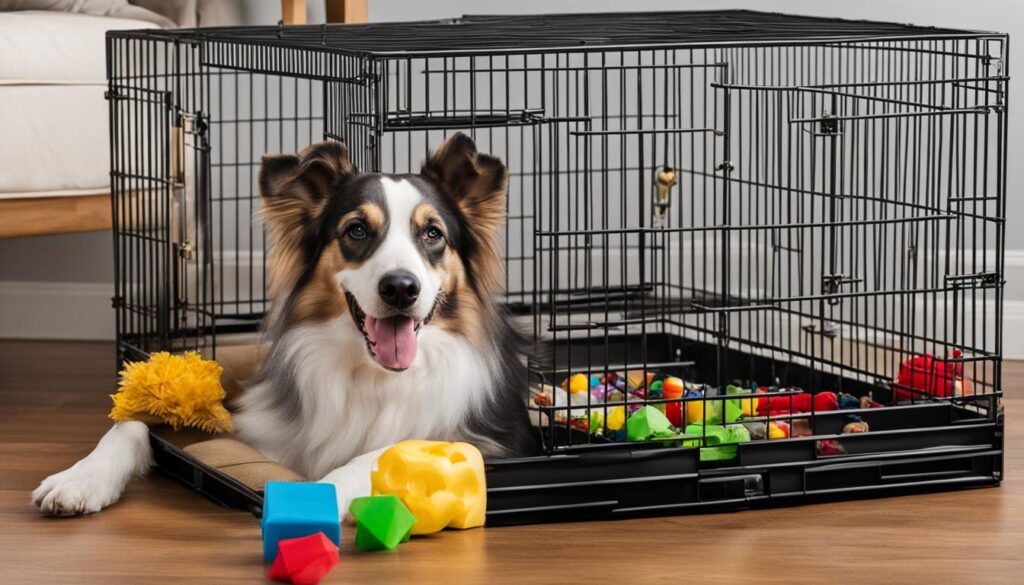
Teaching Basic Commands
Training your hyperactive dog to follow basic commands is essential for their obedience and overall behavior management. By teaching commands like sit, down, stay, come, and quiet, you establish control and improve their response to your instructions.
Start the training process by using short, one or two-word commands that are easy for your dog to understand. For example, when teaching your dog to sit, hold a treat above their head and slowly move it towards their tail. As they follow the treat with their gaze, their natural instinct will be to lower their hind end, eventually resulting in them sitting. Immediately reward them with the treat and praise to reinforce their positive behavior.
Consistency is key when teaching basic commands. Practice these commands daily and gradually reduce the reliance on treats, focusing more on verbal praise and affection as a reward. Be patient with your dog and understand that learning takes time.
Here’s a step-by-step guide to teaching each command:
Sit:
-
Hold a treat above your dog’s head and say, “Sit”.
-
Gradually move the treat towards their tail, encouraging them to lower their hind end.
-
Once they are in a sitting position, reward them with the treat and praise.
-
Repeat this process daily until your dog can sit on command without the treat.
Down:
-
Hold a treat close to your dog’s nose and say, “Down”.
-
Slowly move the treat towards the ground, guiding them into a lying down position.
-
Once they are lying down, reward them with the treat and praise.
-
Practice this command regularly until your dog can lie down on command without the treat.
Stay:
-
Ask your dog to sit or lie down.
-
Show your open palm towards them and say, “Stay”.
-
Take a step backwards, keeping a visual connection with your dog.
-
If they stay in position, return to them, reward them with a treat and praise, and gradually increase the distance over time.
-
If your dog moves, calmly reposition them, say “Stay” again, and repeat the process.
Come:
-
Get your dog’s attention and say their name followed by the command “Come”.
-
Step back and open your arms invitingly.
-
Encourage them to come to you by using an enthusiastic tone of voice.
-
When your dog reaches you, reward them with a treat and praise.
-
Practice this command in a controlled environment and gradually increase the distractions as your dog becomes more reliable.
Quiet:
-
When your dog starts barking or making noise, firmly say, “Quiet”.
-
If they stop barking, reward them with praise and a treat.
-
If they continue to bark, use a distraction technique such as clapping your hands or redirecting their attention to a toy.
-
Once they are quiet, reward them and reinforce the behavior by saying “Quiet” again.
-
Consistently practicing this command will help your dog associate “Quiet” with stopping their barking.
Remember, consistent training, positive reinforcement, and patience are key when teaching basic commands to your hyperactive dog. Gradually, they will become more obedient, improving their overall behavior and strengthening the bond between you and your furry friend.
Importance of Exercise Before Training
Before attempting any training session with your hyperactive dog, it is crucial to provide them with exercise to burn off excess energy. A tired dog is more likely to focus and respond positively to training. Engage in activities like running, playing fetch, or going for a brisk walk to tire out your dog physically. By exercising them beforehand, you set the stage for a productive training session where they can learn and follow commands more effectively.
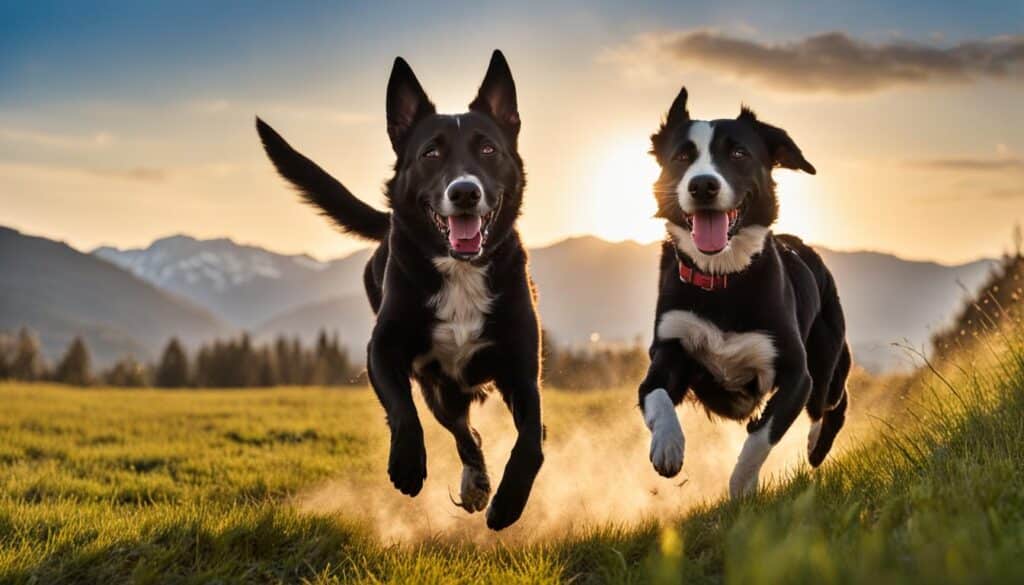
Exercise serves as an outlet for your dog’s high energy levels. By engaging them in physical activities, you allow them to release their pent-up energy in a controlled and constructive manner. This not only helps prevent destructive behaviors at home but also promotes overall well-being for your furry companion.
Beyond burning off energy, exercise has additional benefits for your hyperactive dog. Regular exercise improves their focus and concentration, allowing them to be more attentive during training sessions. It also helps in reducing anxiety and stress, promoting a calmer state of mind in your dog.
Make sure to match the intensity of the exercise to your dog’s stamina and fitness level. Gradually increase the duration and intensity of the exercise over time as your dog gets stronger and builds endurance. Remember to monitor their behavior and offer plenty of water breaks to keep them hydrated.
Keep in mind that exercise alone is not a complete solution for managing hyperactivity in dogs. It should be combined with other training techniques and consistent rules and boundaries. By providing your hyperactive dog with regular exercise before training sessions, you are setting them up for success and creating a harmonious bond between you and your furry friend.
Consult a Professional
If you find yourself struggling to manage your hyperactive dog’s behavior, don’t hesitate to seek professional help. Consulting a veterinary behaviorist or a professional dog trainer can provide you with expert advice tailored to your dog’s specific needs. These professionals have the knowledge and experience to assess your dog’s behavior, provide personalized training techniques, and suggest medication if necessary.
By consulting a professional, you can gain valuable insights into the underlying causes of your dog’s hyperactivity and receive guidance on how to effectively manage and train them. They can help you understand the triggers that contribute to your dog’s hyperactive behavior and teach you techniques to redirect their energy in positive ways.
Professional guidance is especially important if you have tried various training methods without success or if your dog’s hyperactivity is becoming overwhelming. With their expertise, you can build a stronger bond with your dog and create a harmonious living environment for both of you.

